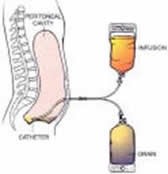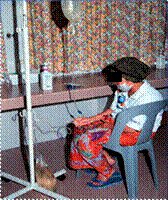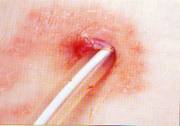How common is this mode of therapy in Malaysia?
In 2010, there was a total of 2360 patients on PD in Malaysia, the majority on CAPD (Continous Ambulatory Peritonela Dialysis) and only 12.5% on APD (automated PD).
What is Peritoneal Dialysis?
Peritoneal dialysis is a modality of dialysis. Here, dialysate fluid is infused into the peritoneal space in the abdomen through a two-way permanent silicon tube which is inserted via a small surgical procedure. The membrane that lines the abdomen (the peritoneum) allows waste and fluid to pass from the blood into the dialysate. The dialysate is subsequently removed from the body. (See diagram below) :-

In Continuous Ambulatory Peritoneal Dialysis (CAPD), the patient connects a bag of dialysate fluid (between 2 to 2.5 L) to the Tenckhoff catheter. This dialysate remains in the abdomen for 4 to 6 hours, following which the dialysate will be drained out of the abdomen and fresh dialysate will be reinfused. For adequate dialysis, 4 to 6 such exchanges are required everyday but on average, only half an hour is needed for each exchange. In between, the patient is free to go about their usual activities. The peritoneal dialysis solution is made up of various salts and sugar (glucose). The concentration of sugar in the dialysate determines the volume of fluid removed (ultrafiltration) from the patient.
The main advantage of peritoneal dialysis is that patients are able to receive diaoysis in their own homes/places of warm. When compared to haemodyalisis, there is a reduce risk of transmission of infections such as hepatitis B and C, reduced risk of anaemia and need for blood transfusion, as well as better preservation of remaining kidney function.

Patient on APD. The macine is portable and can be brought with the patient, even when travelling overseas
What are the factors that influence the choice of CAPD?
These include psychosocial medical factors.
Psychosocial factors include :
- Patient preference and motivation
- Concern with body image (young adults)
- Occupation
- Economic considerations
- Home and workplace environment
- Family support
- Distance from the nearest HD center
Medical factors include :
- Age
- Cerebrovascular and heart disease
- Difficult in obtaining a vascular access for haemodialysis because of small or deseased blood vessels
What are the contraindications for CAPD?
- Extensive peritoneal fibrosis and adhesions arising from previous surgery or inflammatory bowel disease
- Poor eye sight (if no assistant is aailabale)
- Any colostomy, ileal conduit, ileostomy etc
- Psychologically unstable patient
- Severe chronic obstructive airway disease
- Morbid obesity
- Severe diverticular disease of the colon
- Diaphraghmatic leak due to an abnormal connection between the abdomen and chest cavities
What are the complications of Peritoneal Dialysis?
The commonest cause is infections – either exit-site, tunnel infection or peritonitis.

Exit – site infection
Other complications include :
- Technical problems – hernias, leakage, inflow and outflow obstruction
- Metabolic problems – elevated blood curds of cholesterol and sugar, low blood levels of potassium
- Malnutrition
Support group
Malaysian Society of Nephrology – www.msn.org.my.
National Kidney Foundation of Malaysia – www.nkf.org.my.
| Last reviewed | : | 26 April 2012 |
| Writer | : | Dr. Anita Bhajan Manocha |
| Reviewer | : | Dr. Sunita a/p Bavanandan |







